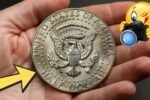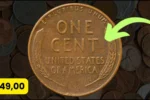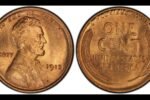The Buffalo Nickel That Sat in a Piggy Bank for 30 Years: For three decades, a small, dusty ceramic pig sat quietly on a shelf in an Ohio home, collecting the occasional loose change tossed in by a family who never gave it much thought.
What they didn’t know was that one of the nickels in that forgotten bank would eventually stun coin experts and collectors alike—a Buffalo Nickel hiding in plain sight, waiting to make history.
A Coin Forgotten by Time
The Buffalo Nickel, also known as the Indian Head Nickel, was minted from 1913 to 1938 and has long been a favorite among collectors for its iconic design and ties to American history. Its front features the profile of a Native American chief, while the reverse proudly displays a bison—believed to be modeled after “Black Diamond,” a buffalo once kept at the Central Park Zoo in New York City.
The coin found in the piggy bank turned out to be a rare 1918/7-D overdate—one of the most coveted varieties in the Buffalo Nickel series. This error occurred when a 1917 die was mistakenly re-engraved with the 1918 date, creating a clear overstrike that is visible with the naked eye. Only a few thousand of these were ever made, and fewer still survive in collectible condition.
The Accidental Discovery
It wasn’t a seasoned numismatist or a treasure hunter who made the discovery. Instead, it was 38-year-old Megan Thompson, who was cleaning out her late grandfather’s belongings when she stumbled upon the piggy bank. Planning to donate the coins or use them at a coin-counting kiosk, she decided to take one last look out of curiosity. That’s when she noticed a nickel that looked “unusually worn but different.”
Megan showed the coin to a friend who dabbled in collecting, and he immediately suspected it might be special. They took it to a local coin shop, and the expert behind the counter nearly dropped his magnifying glass. “I knew what it was the moment I saw the date,” the dealer said. “It’s one of the rarest Buffalo Nickels out there.”
Experts Weigh In
After authentication and grading by a top-tier certification service, the coin was confirmed to be a genuine 1918/7-D Buffalo Nickel in Extremely Fine (EF) condition. While not mint-state, its rarity and historical importance placed it in the five-figure range. Auction houses reportedly estimated its value between $35,000 to $45,000 depending on final bidding.
Professional numismatist Laura Simmons said, “Finding a coin like this in an old piggy bank is like uncovering a piece of lost American history. These overdate errors are so rare that even collectors with decades of experience rarely get to see one in person.”
A Lesson in Loose Change
The story has sparked interest in forgotten coin jars and piggy banks across the country, with social media buzzing about hidden coin treasures. Many are now reconsidering their pocket change, especially older coins that might have quietly sat in drawers or containers for years.
Experts advise anyone curious about their old coins to handle them gently, avoid cleaning them, and consult with a professional before making any decisions about value or sale.
A Memory, a Mystery, a Windfall
For Megan, the Buffalo Nickel was more than just a valuable find—it was a connection to her grandfather, who had unknowingly preserved a rare piece of history. “He wasn’t a collector,” she said. “He just saved coins. I think he’d be amazed to know what was in there.”
Whether it’s tucked away in a shoebox, a cookie jar, or an old piggy bank, treasures like this Buffalo Nickel remind us that history isn’t always locked in museums. Sometimes, it’s hiding in plain sight, waiting for the right moment—and the right person—to uncover it.
FAQs
Q1: What is a Buffalo Nickel?
A: The Buffalo Nickel, also known as the Indian Head Nickel, is a U.S. five-cent coin minted from 1913 to 1938. It features a Native American on one side and a buffalo on the other.
Q2: Why is a Buffalo Nickel in a piggy bank for 30 years significant?
A: Coins like the Buffalo Nickel can gain historical or collectible value over time. Sitting untouched for 30 years might mean it remained in good condition or became rare.
Q3: Can a Buffalo Nickel be valuable after all that time?
A: Yes. Depending on its date, mint mark, and condition, a Buffalo Nickel can be worth more than face value—sometimes significantly more to collectors.




